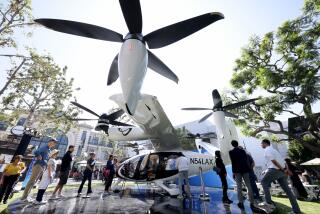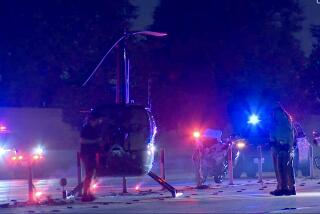Commuting to Work Above the Madding Crowd, Via Helicopter
If all goes according to plan, a handful of employees at ACL Technologies Inc. will soon have a novel way to commute: Theyâll catch a ride to work in a helicopter.
As many as half the 300 employees at the Santa Ana company now live in Riverside and San Bernardino counties. Some spend up to 4 hours on the road each day, arriving tired and frustrated from driving at a snailâs pace in bumper-to-bumper traffic.
That is one incentive for employers to do something about the traffic problem, since employees stressed out from a grinding commute may not be as productive as they could be. But now thereâs an even more pressing reason: On pain of huge fines, Southern Californiaâs larger companies must help reduce smog by cutting the number of employees who drive to work alone.
Most companies are starting car and van pools and instituting other fairly prosaic measures. Nobody has yet come up with a practical way to get employees--other than a few top managers--to work by helicopter. If ACL Technologiesâ proposal succeeds--and it is far from certain that it will--it would be the first, says the Orange County Transit District and other local agencies that monitor commuting patterns.
Sales Manager Greg Ward thought about the traffic problem each morning on his way to work from San Clemente as he also was stuck in traffic. Ward, who is a pilot, suddenly had an idea: Why not use a helicopter to airlift employees over the snarled traffic?
The problems seemed insurmountable at first. The biggest was cost: At $500 an hour for a chopper with four passenger seats, most middle-level employees couldnât afford the ride.
But then Ward found a charter company, Corona-based Skyhooks Inc., which agreed to charter a chopper at $175 an hour in return for a long-term commitment.
âAll of a sudden, the numbers started to break even, and it looked like the thing could work,â Ward said.
Hereâs how ACL made it feasible: To bring in 12 employees--eight from the Corona airport in Riverside County and four from an airport near Pomona at the far eastern tip of Los Angeles County--the company estimated it would take three trips each way in a four-passenger helicopter. That would take 2.3 hours of flying time a day, and at $175 an hour, thatâs $403 a day.
ACL picked 12 employees making at least $40,000 a year, which works out to about $19 an hour. The company also estimated that each employee costs it another $19 in overhead; things like taxes, insurance, vacation, training. Thatâs a total cost per employee of $38 an hour.
Ward then had this inspiration: If each employee worked an extra hour a day with no pay, the company would save $456 daily. Since the chopper cost only $403 a day to move those 12 people, ACL could pay for the helicopter and still save $53 a day. The 12 quickly agreed, since most of them will still get home sooner at night, even after working the extra hour.
Privately held ACL makes equipment for testing airplane parts. The airlines are buying lots of planes, and ACL sales are booming too--an estimated $30 million this year, up from $24 million last year.
But engineers qualified for this corner of the engineering business are hard to find. So ACL wants to keep the people it has, even if that means hiring a helicopter. One employee who lives in Corona, for example, just quit because he got fed up with the rigors of commuting. He took a job near his house at a cut in pay, Ward related.
There isnât enough housing being built in Orange County to go around, and prices for what is built are soaring.
So a lot of blue-collar workers and middle-level employees have joined the exodus to Riverside and San Bernardino counties--the Inland Empire--where housing is cheaper. But their jobs remain in Orange County, and the east-west roads are clogged each rush hour with some of the worst traffic jams in Southern California, where tie-ups can assume epic proportions.
For instance, sometimes it takes Judy Gamble 4 hours a day to make the commute from her home in Norco, only 33 miles away from the ACL plant as the crow flies.
âIâm so sick of this drive, Iâd do almost anything to get out of it,â said Gamble, the companyâs customer service manager.
Although she has never ridden in a helicopter before, she said she is not really nervous about the trip.
âAlthough the first time it landed in the parking lot, it did look a bit small,â she admitted.
Even working the extra hour, she expects to be home an hour earlier each day via helicopter.
Project manager Mark F. Sosniecki gets up every day at 4 a.m. to beat the traffic and shave half an hour or so off his drive from southeastern Corona. Thatâs enough to sell him on the helicopter, even though he has never ridden in one.
âWhen I moved out there in 1980, there was no traffic problem,â he said. âIn the last 5 years, it has gotten really bad, and now itâs starting to get bad even at 5 a.m.â
But there are still some roadblocks--or cloudy skies, if you will.
The company needs a permit from the city of Santa Ana to use its back parking lot as a helicopter pad. Getting such a permit takes a good bit of work and time, and the city only recently agreed to review ACLâs plans and hold a hearing.
Then the Federal Aviation Administration must also approve the helicopter flights; among the things it wants to know are if there are any smokestacks, microwave towers, churches, schools and the like within a 1-mile radius of the landing zone.
âI spent a lot of lunchtimes driving around identifying buildings,â Ward said. âIf Iâd known there were going to be this many hassles, I might not have done it.â
The factory is in an industrial neighborhood, and Ward says that he doesnât anticipate any problems getting both permits within the next 3 months. Then a monthlong trial begins, involving at first only four employees, including Gamble and Sosniecki.
Then thereâs the angle nobody wants to talk much about--the danger. Ward had to convince Chief Executive Officer Joe Abdo, who founded the company 35 years ago, that jet helicopters were the safest small aircraft in the skies.
By using a charter firm, the company hopes to cut its exposure to liability suits in the event of a crash. It will also make its employees sign forms acknowledging the risk of flying. That risk, Ward says, is slight: Based on statistics, the company can expect a mishap every 43 years, he noted.
Still, of the 20 employees that he originally asked about flying, only two said they would prefer to stay on the ground.
And the helicopters can go up in weather that would ground a light plane. On really stormy days, the employees will drive, just like everybody else.
While it started out as a solution to a vexing problem, the helicopter is now part of the traffic-reduction program that ACL--like every other large Southern California company--must submit to the South Coast Air Quality Management District in order to avoid those huge fines.
Eventually, Ward wants to expand the program to the companyâs other engineers, including himself. But thatâs in the future, because there are now no approved landing pads in San Clemente, he says.
He is also looking for executives of other companies who want to commute in the opposite direction--into the Inland Empire--in order to fill up the empty choppers on their return trips and cut costs even more.
And finally, if the whole thing works, there could be a sideline business in it for ACL, Ward pointed out.
âBut thatâs way in the future,â he said. âWeâre still trying to get this thing to work.â






